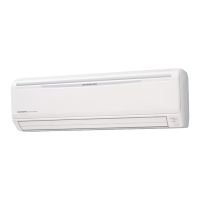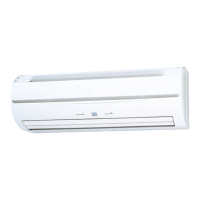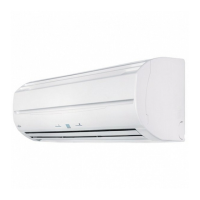En-5
4.3.3. Pipe connection
CAUTION
Be sure to install the pipe against the port on the indoor unit correctly. If the centering
is improper, the fl are nut cannot tighten smoothly. If the fl are nut is forced to turn, the
threads will be damaged.
Do not remove the flare nut from the indoor unit pipe until immediately before
connecting the connection pipe.
Hold the torque wrench at its grip, keeping it at a right angle with the pipe, in order to
tighten the fl are nut correctly.
When the fl are nut is tightened properly by your hand, hold the body side coupling with
a separate spanner, then tighten with a torque wrench.
Torque wrench
Tighten with 2 wrenches.
Holding wrench
Flare nut
Connection pipe
Indoor unit pipe
(Body side)
Flare nut [mm (in.)] Tightening torque [N·m (kgf·cm)]
6.35 (1/4) dia. 16 to 18 (160 to 180)
9.52 (3/8) dia. 32 to 42 (320 to 420)
12.70 (1/2) dia. 49 to 61 (490 to 610)
15.88 (5/8) dia. 63 to 75 (630 to 750)
19.05 (3/4) dia. 90 to 110 (900 to 1,100)
4.4. Installing heat insulation
CAUTION
After checking for gas leaks (refer to the Installation Manual of the outdoor unit),
perform this section.
Install heat insulation around both the large (gas) and small (liquid) pipes. Failure to
do so may cause water leaks.
After checking for gas leaks, insulate by wrapping insulation around the 2 parts (gas and
liquid) of the indoor unit coupling, using the Coupler heat insulation.
After installing the Coupler heat insulation, wrap both ends with vinyl tape so that there
is no gap.
Body
Coupler heat insulation
No gap
Coupler heat
insulation
Be sure to overlap the
insulation
CAUTION
Must fi t tightly against body without any gap.
CAUTION
Install heat insulation around both the gas and liquid pipes. Failure to do so may
cause water leaks.
Use heat insulation with heat resistance above 120 °C. (Reverse cycle model only)
In addition, if the humidity level at the installation location of the refrigerant piping is
expected to exceed 70 %, install heat insulation around the refrigerant piping. If the
expected humidity level is 70 to 80 %, use heat insulation that is 15 mm or thicker and
if the expected humidity exceeds 80 %, use heat insulation that is 20 mm or thicker. If
heat insulation is used that is not as thick as specifi ed, condensation may form on the
surface of the insulation. In addition, use heat insulation with heat conductivity of 0.045
W/(m·K) or less (at 20 °C).
4.3. Flare connection (pipe connection)
WARNING
Tighten the flare nuts with a torque wrench using the specified tightening method.
Otherwise, the fl are nuts could break after a prolonged period, causing refrigerant to
leak and generate hazardous gas if the refrigerant comes into contact with a fl ame.
4.3.1. Flaring
Use special fl are tool exclusive for R410A.
(1) Cut the connection pipe to the necessary length with a pipe cutter.
(2) Hold the pipe downward so that cuttings will not enter the pipe and remove any
burrs.
(3) Insert the fl are nut (always use the fl are nut attached to the indoor and outdoor
units (or RB unit) respectively) onto the pipe and perform the fl are processing with
a fl are tool. Use the special R410A fl are tool. Leakage of refrigerant may result if
other fl are nuts are used.
(4) Protect the pipes by pinching them or with tape to prevent dust, dirt, or water from
entering the pipes.
Die
A
B
Pipe
Check if [L] is fl ared uniformly and
is not cracked or scratched.
Pipe outside diameter
[mm (in.)]
Dimension A [mm]
Dimension B
-
0
0.4
[mm]
Flare tool for R410A,
clutch type
6.35 (1/4)
0 to 0.5
9.1
9.52 (3/8) 13.2
12.70 (1/2) 16.6
15.88 (5/8) 19.7
19.05 (3/4) 24.0
When using conventional (R22) fl are tools to fl are R410A pipes, the dimension A should
be approximately 0.5 mm more than indicated in the table (for fl aring with R410A fl are
tools) to achieve the specifi ed fl aring. Use a thickness gauge to measure the dimension A.
It is recommended that a R410A fl aring tool is used.
Widh across
falts
Pipe outside diameter
[mm (in.)]
Width across flats of
Flare nut [mm]
6.35 (1/4) 17
9.52 (3/8) 22
12.70 (1/2) 26
15.88 (5/8) 29
19.05 (3/4) 36
4.3.2. Bending pipes
If pipes are shaped by hand, be careful not to collapse them.
Do not bend the pipes in an angle more than 90°.
When pipes are repeatedly bend or stretched, the material will harden, making it
diffi cult to bend or stretch them any more.
Do not bend or stretch the pipes more than 3 times.
CAUTION
To prevent breaking of the pipe, avoid sharp bends.
If the pipe is bent repeatedly at the same place, it will break.
9373370130-01_IM.indb Sec1:59373370130-01_IM.indb Sec1:5 7/12/2012 2:29:43 PM7/12/2012 2:29:43 PM

